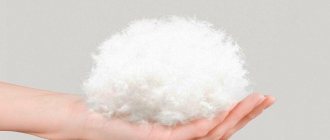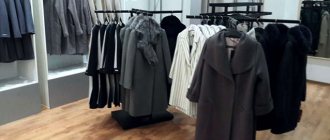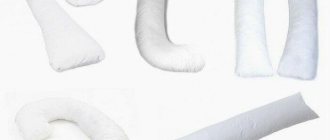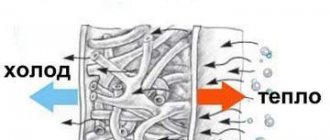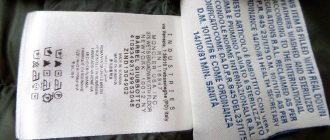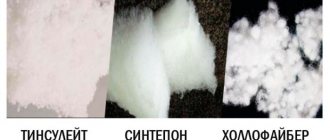How to care for clothing with silicone insulation:
- Machine washable at 30–40°C;
- use liquid laundry detergents;
- Powders and chlorine-containing products are contraindicated;
- Soaking is contraindicated.
Choose the color of clothing according to your color type, and the style according to your body type. Don't forget about a hat and warm shoes for the weather - they will keep you 100% warm.
In recent years, products with artificial insulation have increasingly begun to appear on the women's outerwear market. They began to displace sheepskin and down due to their practicality, durability and cost, which is several times lower and more pleasant for our women. Sintepon, holofiber, Thinsulate today have become common terms that can be heard when buying a winter jacket or coat.
Caring for things with synthetic insulation
Items with synthetic insulation are easy to use and care for. In order for the filler to retain its shape and properties, you need to select the correct temperature and detergent suitable for processing products made from synthetic fibers. The optimal water temperature for washing a jacket is 30-35°C.
Detergent compositions with bleaching components, enzymes and strong chemical effects can harm the structure of the fibers, so when choosing them you need to carefully study their composition and recommendations for use.
A good item with padding polyester filler, regardless of its density, should have a number of characteristics:
- heat-saving effect;
- volume, elasticity and lightness of products;
- recovers quite easily after washing;
- hypoallergenic;
- tolerates both dry cleaning and washing at home at a temperature of 30 degrees;
- there are no conditions for the appearance of saprophytes, mold and moths.
The low cost of the material allows it to be used in a wide variety of areas of life. Filling of different densities is used not only in outerwear, but also in the textile industry for sewing quilted bedspreads, blankets, as a layer in mattresses, pillows and soft toys.
How to choose quality insulation
Air is the best thermal insulator. Therefore, the more still air there is in a unit of insulation, the better and longer the clothing retains heat. And the lighter the fibers, the more cavities inside to hold air. Therefore, the most suitable option is lightweight insulation with low density.
In addition, high-quality material must be durable and wear-resistant, environmentally friendly and safe. It should not absorb moisture and foreign odors, lose shape, wrinkle and roll, shrink and become thinner during use.
A down jacket with natural filling should have a label that says “Down,” but such clothing is rare. As a rule, feathers are added to natural down and such products are produced with the “Feather” mark. In a quality product, the volume of natural down is 60-80%. The fluff indicator contains the first digit, and the feather indicator contains the second. For example, 70/30 means that the product contains 70% down and 30% feather.
The “Wool” label indicates that there is wool batting inside. The marks “Waltern” and “Polyester” indicate padding polyester and other synthetic fillers. Under no circumstances choose products with the “Cotton” label. Since this is no longer a warm down jacket, but a standard jacket with a lining.
High-quality branded outerwear has smooth and durable seams, reliable and durable fittings. The label is made in the form of a stripe or made of metal or fabric. Inside the product, on the side seam, there is always a label with recommendations for clothing care. In order not to buy a fake, it is better to purchase clothes in branded stores and departments.
Branded products must have quality certificates. In this case, collars, hoods, belts and other parts are unfastened and removed. Choose insulation with stitching rather than a quilted lining. The lines should not be located closer than ten centimeters to each other. Do not use diamond-shaped quilting, as it reduces the insulation properties.
Insulation polyester siliconized fiber: description and properties
A wide range of fillings for the manufacture of blankets, clothes and soft toys creates the prerequisites for studying the properties of the material in detail and not making a mistake in choosing. When purchasing blankets and pillows, you should familiarize yourself with the composition of the filling, since not only the rules of care, but also the quality characteristics of the product and its durability depend on this. One of the common materials used in the manufacture of blankets is siliconized fiber.
- Characteristics and properties
- Types of siliconized fillers
- Varieties by density
- Advantages and disadvantages
- Application
- In blankets and pillows
- In winter clothes
- Comparison of siliconized fibers with others
- Care instructions
Natural insulation materials
Natural down or down + feather is an environmentally friendly, lightweight and durable insulation for clothing, which, due to its specific natural properties, prevents moisture from being absorbed. It has high thermal insulation qualities, warms well and is suitable for severe frost.
However, it is an allergenic material and is therefore not recommended for newborns and infants. In addition, down is a suitable breeding ground for mites and attracts dust well.
Wool or sheepskin is a durable and hypoallergenic material that is resistant to wear and tear. Harmful microbes and insects do not accumulate here. This is a suitable insulation for children's overalls and envelopes, which will warm the baby even at minus 25 degrees. Woolen lining or lining is used for jackets, coats and other outerwear, for making warm pants, jackets and sweaters. Read about caring for woolen items here.
High-quality wool does not itch, does not absorb sweat and foreign odors. It retains heat well, but at the same time allows moisture to pass through and is not always suitable for active use. In addition, it is heavy in weight compared to other insulation materials. Therefore, wool is used mainly for babies under one year old and sedentary children.
Mixed insulation
Batting is a cheap type of insulation, which includes wool, viscose, cotton, synthetic fibers and industrial waste. It has low thermal insulation and heavy weight. It keeps moisture inside and is rarely used today.
Sherstepon is a modern Russian-made insulation material that contains natural wool and polyester fibers. The material is used for the manufacture of outerwear, sports equipment and bedding.
It is characterized by lightness and elasticity, high thermal insulation. However, sherstepon can cause an allergic reaction. In addition, when exposed to strong moisture, it becomes deformed. Without proper processing, moths appear in products.
Alpolux is a modern, warm and lightweight insulation that combines natural Merino wool and high-quality microfiber. Includes the best properties of natural and synthetic filler. It warms and retains heat well, is safe and does not cause allergies, does not wrinkle and quickly regains its shape. Soft, flexible and elastic material.
Difference from holofiber
In another way, holofiber is also called siliconized padding polyester, but this is a slightly different material, although it is also used as a filler.
A characteristic feature of difference is shine. If you take a piece of padding polyester and holofiber in both hands, the second one will be softer and looser, as if in lumps. These fluffy balls are filled with soft toys.
It is also possible to divide padding polyester into layers, since it is produced in sheets. Holofiber is round in shape, and this will not work with it. Therefore, if you are sewing, for example, a quilt, it is better to use padding polyester.
To choose the right material, you need to know what types of padding polyester are available. According to the production method there are 3 varieties:
- Thermal. The fibers bond together when exposed to high temperatures. Polyester can melt when heated, so some of the hairs stick together and form a layer. This type is more wear-resistant because no glue or other substances are used, therefore, the fibers are more tightly bonded to each other.
- Glue. This is the cheapest padding polyester presented. The fibers in it are combined using special adhesive emulsions, usually PVA. It is not dangerous to humans and does not cause allergies or any consequences, but only if the manufacturer has taken care of high-quality raw materials. Unfortunately, to reduce costs, various harmful impurities can be added to the glue. In general, adhesive padding polyester cannot be called high quality, because the glue from the fibers is washed out after some time.
- Needle-punched. The hairs are connected to each other on a special machine with needles that bend the fibers in different directions. Due to this, they are securely fastened to each other, this is the highest quality method of all presented.
Synthetic insulation
Synthetic insulation - 100% polyester. One of the most common and affordable polyester insulation is synthetic winterizer. This material is made by bonding polyester fibers.
This insulation is distinguished by its low cost, volume and lightness, and fairly high thermal characteristics. However, it has significant disadvantages and disadvantages, including a tendency to deformation, increased moisture permeability and fragility.
Sintepon does not allow air to pass through and becomes deformed after exposure to large amounts of moisture and active use. So, after washing it loses up to half its thickness. Today this material is used to make cheap demi-season clothing, since it is not suitable for temperatures below minus ten degrees.
Today, synthetic winterizer has been replaced by better and more practical materials, including Thinsulate, Isosoft and Holofiber. Such products are distinguished by high thermal insulation.
At the same time, isosoft and holofiber can withstand cold winters and temperatures of minus 25 degrees. And Thinsulate is suitable for use even at temperatures lower than minus 40 degrees. In addition, ultra-modern insulation materials for clothing, including shelter, silicone and thermofin, are also becoming popular.
Advantages and disadvantages of silicone pillow filling
Each property of silicone filler can be considered its advantage.
- It is soft and light, but it is very elastic, providing good support to the cervical spine. To restore the shape of a product with silicone, just beat it.
- Special fiber processing makes the filler highly hypoallergenic. The material was specially developed for people prone to this disease.
- Easy to care for and durable. Silicone pillows can be washed in a washing machine (on a delicate cycle at 30°C). With proper care, the material will retain its quality characteristics for three years.
- Inexpensive. The cost of a pillow with silicone is much lower than a feather or down pillow.
Among the disadvantages of the material, it is worth highlighting its ability to accumulate static electricity. Using natural pillowcases and duvet covers will help solve this problem. Another wash will get rid of the unpleasant effect.
The warmest silicone insulation
Holofiber is characterized by availability, high quality and reliability. It has a uniform porous structure, holds its shape well, and does not crumble even after prolonged use. Thinsulate is warmer and lighter than holofiber. It can withstand lower temperatures, but also costs much more.
Thinsulate is the warmest material. It retains heat and does not deform after washing or prolonged use, is able to return to shape, and is resistant to wear and moisture. It is used to insulate everyday winter clothing for children and adults, as well as for the manufacture of workwear and suits. Suitable for use in harsh extreme conditions and used to fill cases, soft toys, pillows and blankets.
Isosoft is also considered one of the warmest materials. At the same time, it is cheaper than Thinsulate, but has a narrow scope of application. It is used only for insulating winter and demi-season clothing, but is not suitable as a filler. It is characterized by resistance to wear, the insulation fibers do not unravel and retain their original shape for a long time.
Isosoft protects against cold air getting inside and allows moisture to escape freely. Used for sewing winter sportswear and children's clothing. It is the basis of children's clothing of such popular brands as Lenny and Reima.
Modern silicone insulation
Shelter insulation is a Russian microwave-based polyester insulation that combines the properties of natural and synthetic fibers. This material is distinguished by flexibility and elasticity, airiness and lightness, and high thermal insulation characteristics. It does not shrink after washing and dries quickly, provides comfortable heat transfer and allows the skin to breathe.
Shelter is characterized by uniformity, so it does not bunch up, does not wrinkle and quickly returns to its previous shape. Does not cause allergies, does not emit toxic or harmful substances. Used for the manufacture of bedding, winter, demi-season and sportswear, children's suits and workwear. Suitable for extreme and harsh conditions, but expensive.

